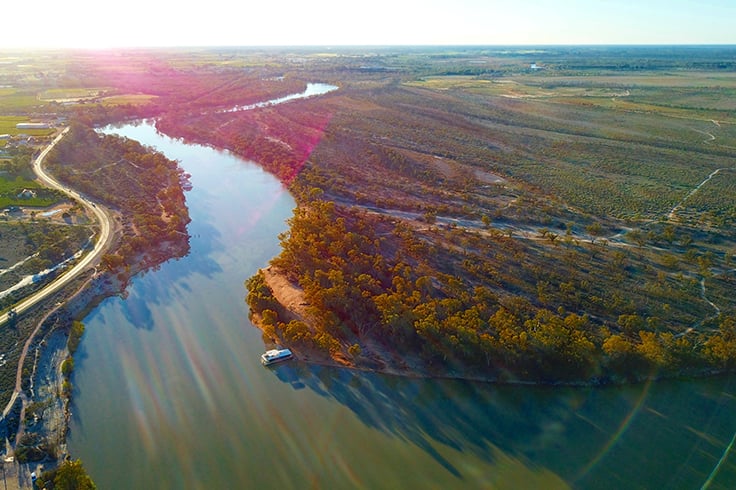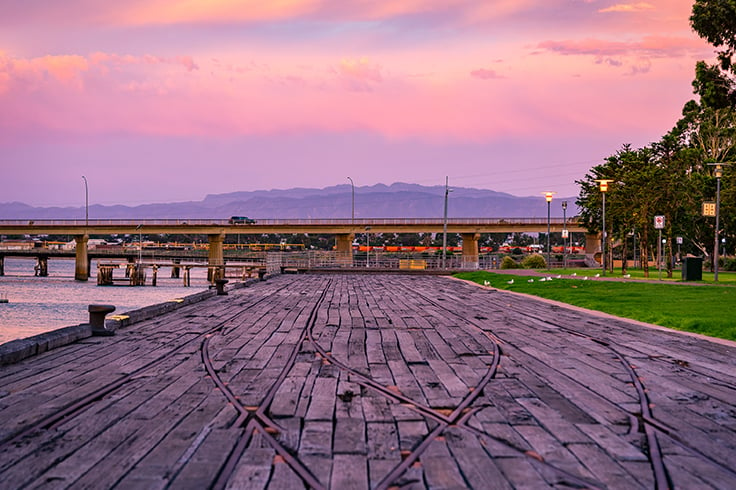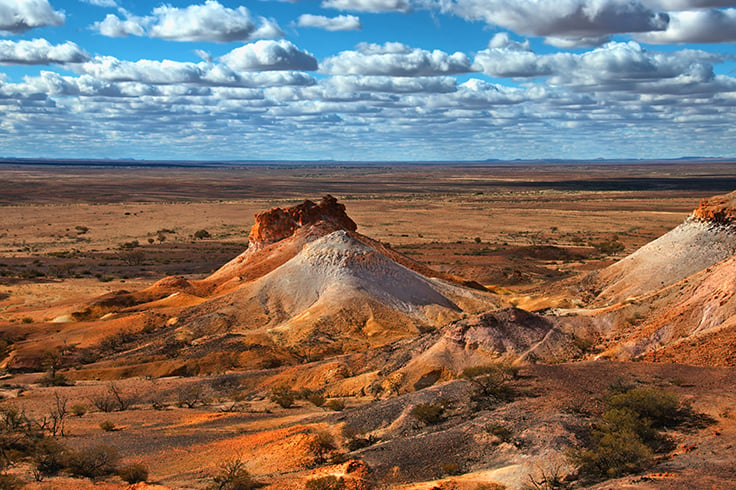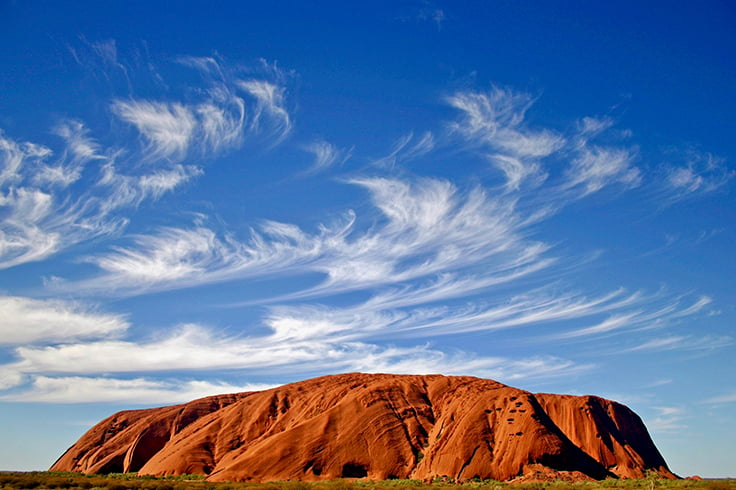Melbourne to Uluru road trip itinerary
Go the other way: Melbourne to Uluru road trip itinerary
While probably not actually true, we like to think that the famous saying, ‘variety is the spice of life’ was written about a road trip from Melbourne to Uluru. (Okay, we know it’s not true, but it could have been).
As you traverse this 2,313km route, you’ll pass craggy mountain scenery, lush native forests, and barren wastelands. All before the land itself changes slowly to the red-gold shade that is so synonymous with the Australian outback.
If you’re short on time (like real short) or a little cray-cray, you can drive from Melbourne to Uluru in 25 hours. But, imagine racing past the pink-mirrored waters of Dimboola. Or bypassing a trip to the opal mines of Coober Pedy. Nah, we’re all about the long way round, the slow road, the detours, just because. If you’re with us, read on for an itinerary more eye-popping than an episode of Game of Thrones.
We’ll sort the A-to-B route, you decide on how many days to spend at each spot. At a minimum, this would take you five days and nights (but you’d be missing out). At a max? Well, that’s up to you!
Melbourne to the Grampians
Whether you’re departing our Melbourne Airport or Melbourne City branch, your destination is the same. You’re heading to the Grampians!
One of Victoria’s more famous destinations, the Grampians is a sacred natural stunner. Rugged sandstone mountains, flora-filled gorges, indigenous rock art, and wildlife out the wazoo. What’s not to love? While you could spend days hiking the trails, swimming in rock pools, or watching kangaroos and wombats feed, we’ve selected the best stops for this north-westward outback-bound journey.
In the northern section of the Grampians, we love the spectacular views on the Hollow Mountain Walk or Mt Zero Track. Only four minutes apart, both are worthy of the butt-ache and can be completed in less than two hours. And a cool bonus? Just 15 minutes before you reach either hike, there is a Giant Koala roadside statue in Dadswell Bridge. Perfect for an Insta-pic and leg stretch!
Distance: 317km; 3 hours 40 minutes of driving.
Overnight: Stay in Horsham for a choice of accommodation options.
Horsham to Mildura
Rise early for a dawn display of epic proportions. Only 30 minutes from Horsham is Dimboola, where you’ll see a small, round lake, famous for its pink hues. At sunrise, the sky and land merge as one to create a fiery palette. It’s a nature-based, #blessed mindfulness moment.
The pink tones are created from the pigment excreted from a microalga that calls the lake home. At times, it’s a baby pink tinge; at others, it’s the colour of a flamingo. The weather, time of year, and water levels impact how pink the lake water is, with spring/summer purported to be the best time to visit.
Pro tip: if there is little in the way of water when you visit, scratch the salty crust, and you’ll find the pink tones underneath.
Continue on with your heart full to the artisanal town of Mildura. Most people connect a trip on the Murray River with an Adelaide vacay, but on this itinerary, you’re going to access it further north! From Dimboola, it’s a three-hour drive.
Mildura is known as the food bowl of Australia, so at the very least, make some time to enjoy a picnic curated from the farmer’s market or a meal at a paddock-to-plate restaurant. We encourage time on the Murray River itself, whether that’s kayaking, a cruise, or a night (or two) on a houseboat. If you do decide to park up and stay for a night or two, that leaves plenty of time to explore the local wineries and cellar doors, too. Yum.
Distance: 330km, 3 hours 45 minutes of driving
Overnight: Get out on the water with Mildura Houseboats
Mildura to Port Augusta
A lengthy travel day today, but it marks a shift towards the Red Centre. Port Augusta is nicknamed the ‘Gateway to the Outback’. It’s also known as the ‘Crossroads of Australia’, as the iconic Ghan and Indian Pacific trains routes meet here.
You just may not want to spend more than one night here as it’s more a junction town than a tourist hotspot. But, that doesn’t mean there aren’t some treats in store.
The most impressive attraction in Port Augusta is the Wadlata Outback Centre, offering a fascinating display of Aboriginal heritage, culture, and history. It’s the history of Australia at in its junction city.
The Australian Arid Lands Botanic Garden also acts as an educational experience. Only this time, it’s a living, breathing garden demonstrating the flora and fauna that flourish in the country’s driest zones. The native-inspired food in the café is yum, too; on the menu, sample the dishes with boobialla, wattle seeds, and quandong.
Distance: 532km; drive approximately 5 hours 45 minutes.
Overnight: Spend the night at the Pastoral Hotel Motel, built during Port Augusta’s late 19th century boom years.
Side trip: if you have some extra time, research a detour to the spectacular Flinders Ranges, before rejoining this route.
Port Augusta to Coober Pedy
It’s time to head into the Red Centre! Woop! Although you’ll only have been on the road around 2 hours, stop at Spud's Roadhouse Motel. Located in Pimba, a 50-person settlement, Spud’s is good for a feed and a uniquely outback experience. You can also fuel up here.
From Spud’s, detour slightly to Woomera for something a tad out of the ordinary. Although 200 people live here, it has a ghost town feel. Woomera was formerly an artificial British military town from 1947 to 1980; all ‘locals’ developed, tested, and launched missiles here. It’s not a thriving town now. In fact, if you were taking bets on how many locals you’ll see, you’d lose if you went into double digits. Visit the old missiles before continuing on to Coober Pedy.
From Woomera, it’s the final four-hour stretch of driving. The excitement builds as your JUCY wheels get you closer to the famous underground town of Coober Pedy. Take the chance in Glendambo to fuel up and buy some more over-priced snacks: it’s another 250km until you reach Coober Pedy and the next gas station.
The drive for the next 2.5 hours becomes almost hypnotic as the orange soil is broken up with little more than desert brush, sandhills, and saltbush. An excellent opportunity to play a few road trip anthems, perhaps?
Coober Pedy is the most famous location in inland South Australia. Not only because Mad Max III was filmed here, but also because 70% of the 3,500 residents live underground. They do so to avoid the heat, with the highest recorded temp cracking 47.8c! A dry 30-35c is more common in the summer months; in winter, night temperatures can drop as low as 6c.
A fascinating question to explore in Coober Pedy is why people claimed such an inhospitable place as their home? For the opal mining! In 1915, fossickers discovered the world’s largest haul of opals. To find out more about the town’s development, visit the Umoona Opal Mine & Museum, with three tours daily. Faye's Underground Home is a real-life example of a dugout home, and Faye spills the beans on life in Coober Pedy.
We recommend staying at least two nights in Coober Pedy, so you have at least one full day to explore. That means you have time to go fossicking for your own opals and for sunset at Breakaways Conservation Park.
One last stop: if you’re as into wildlife as we are, then no Coober Pedy visit is complete without a stop at Josephine's Kangaroo Orphanage. Here orphaned joeys are cared for and there’s indigenous art to view in the gallery.
Distance: 570km; drive time 6 hours.
Stay: Lookout Cave Motel is our favourite underground accommodation.
Coober Pedy to Uluru
The big day. The centre of Australia. The country’s most iconic natural and sacred landmark. It’s a full day of driving so rise with the sun to accommodate leg-stretches, and roadside stops so you arrive before sundown.
Your first stop of the day is the Dingo Fence, about 50km out of Coober Pedy. Some 5,600km long, the Dingo Fence was built in the 1800s to keep dingos from decimating sheep stations. It’s not well-signposted so keep an eye out as you drive.
Take a pit stop in South Australia’s last town, Marla, population 70. Another two hour’s north, your legs will thank you for hopping out of the car at the ‘welcome to the Northern Territory’ sign. You can now say you’ve driven three Australian states in three days! Carry on to Kulgera for lunch at the Kulgera Roadhouse.
You have a couple of options here. It’s another four hours drive to Uluru. If that seems like some wrist-twisting torture (or you think you’ll be driving after dark), travel another 45 minutes to Ghan and a call it a night. The Erldunda Roadhouse is a 3-star motel for a one-night stop.
Alternatively, #nevergiveup. Keep going through the dusty-orange desert towards Uluru-Kata Tjuta National Park. Your heart may soar as you see a flat red rock in the distance – is that it? Nope, you’re looking at Fuluru (fake-Uluru), which is actually the lesser well known Artila (Mt Connor). If time permits, aim your arrival time for sunset and head straight to Uluru’s viewing platform.
Distance: 758km; 8 hours 30 drive time.
Stay: Our most treasured Uluru experience is to camp in a swag. Like a tent for one with a foam base, swags traditionally allow you to have your body covered, but your face open to take in that million-star view. Buy your swag online before you depart Melbourne, or have it waiting for you at the Ayers Rock Campground (call to check).
Uluru Explored
If you ask a past visitor to Uluru their main regret, it’s the amount of time they spend there. Sure, you can tick the main sights off reasonably quickly, but this spiritually significant monolith offers infectious tranquillity that leaves you wanting more. As Uluru changes colour with the position of the sun, allocate activities at different times to absorb it all. Your pre-requisite national park pass is for three days, which works kinda like a guideline.
No matter how long you spend at Uluru, you’ll want to include the following sights. The Uluru Cultural Centre is a fountain of wealth on the rock and the region. You can also take the 1.5km Liru Walk from the centre to the foot of Uluru. It feels symbolic as you take that path so considering separating from your group to really absorb the atmosphere of it.
Another walk is the 1.5 hour Mala Walk; at sunset, it is surprisingly quiet. For the full Uluru Circuit, visit after your sunrise viewing session. Walk clockwise around the 10km track. It’s our fave.
By night, visit the artistic Field of Light. This giant display features 50,000 spindles of light, across acres of the outback desert and is a captivating display. If you’re not in a swag at night, the Sounds of Silence is a swanky four-hour dining experience under the star-filled outback sky. The two experiences can be paired together.
If you’ve fallen for the charms of the Red Centre, consider extending your trip with further exploration of Kings Canyon, Kata Tjuta (the Olgas), and the Henbury Meteorite Craters.
One Last Note: Outback Driving
An essential aspect of driving in the outback is to reach your destination before sunset, ideally an hour before. By avoiding dusk and night driving, you mitigate the roadkill horrors that you’ll see as you drive. Jumping kangaroos, wayward sheep, and wandering camels are threats by sundown. Even by day, keep your wits about you, as emus like to wander.
Also, it’s good to know that this drive is fully accessible by 2WD, though do heed any signs. Download some podcasts or create a sing-a-long playlist as mobile reception is spotty if you’re trying to stream some top tunes.
And lastly, have a blast!! Tag us #jucyworld so we can see your roadie Melbourne to Uluru photos.



